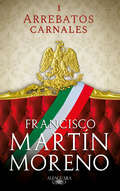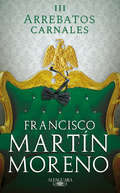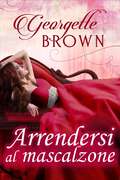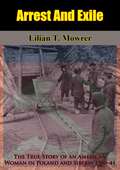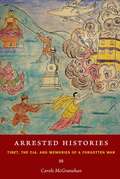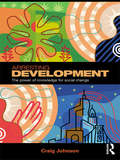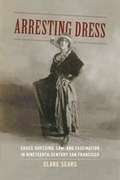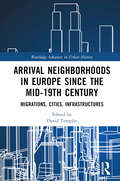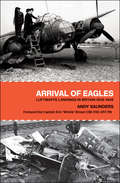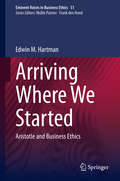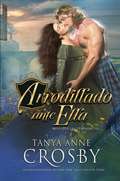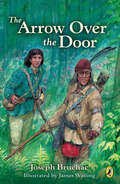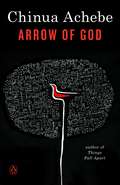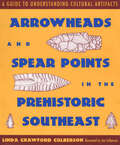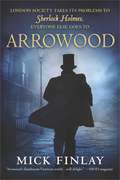- Table View
- List View
Arrebatos carnales (Arrebatos carnales #Volumen 1)
by Francisco Martín MorenoUn libro que nos informa, que nos descubre secretos de alcoba y que nos recuerda nuestra propia humanidad. «Resulta inadmisible estudiar las biografías de los grandes personajes de nuestra historia con un criterio moralista o religioso que excluya sus inclinaciones sentimentales o ignore los arrebatos carnales en que pudieron haber caído, víctimas ¿afortunadas? de una obnubilación permanente o pasajera. El amor constituye la columna vertebral de las relaciones humanas. ¿A dónde se va en la vida sin un cómplice con quien se comparten secretos exquisitos en la cama?» Francisco Martín Moreno, con su fresco, cercano, pero a la vez riguroso estilo, nos invita a humanizar, desde las pasiones y afectos, a esos personajes históricos que han cambiado o influido en la historia de México. Así,en Arrebatos carnales I, el lector conocerá las intimidades de la poeta y escritora Sor Juana Inés de la Cruz, del político José Vasconcelos, del libertador José María Morelos, del emperador Maximiliano I, del dictador Porfirio Díaz y del célebre revolucionario Pancho Villa.
Arrebatos carnales II (Arrebatos carnales #Volumen 2)
by Francisco Martín MorenoUna vez más, el autor nos hace disfrutar de la historia de México conociendo sus entresijos carnales y sus pasiones. «Una prueba para demostrar que no me dejé impresionar por los comentarios adversos ni me importó que me llamaran irreverente, entre otros calificativos, por haberme atrevido a bajar de sus respectivos pedestales a los grandes protagonistas de la historia de México y por exhibirlos como figuras de carne y hueso con sus fortalezas y debilidades [...] Aquí está Arrebatos carnales II.» Francisco Martín Moreno regresa con grandes hombres y mujeres de la historia y sus amores. Para abrir apetito comienza con la Güera Rodríguez, mujer hermosa y estratega audaz, en amoríos con Iturbide; también nos lleva de la mano por la alcoba de Diego Rivera y sus múltiples amantes, mientras vemos de perfil a una Frida Kahlo rompiendo moldes; otra mirada dura de las pasiones es la de Isabel Motecuhzoma, hija del gran Motecuhzoma Xocoyotzin, para seguir con la entereza de doña Josefa Ortiz de Domínguez y cerrar, como una gran cereza, con los arrebatos de don Lázaro Cárdenas.
Arrebatos carnales III (Arrebatos carnales #Volumen 3)
by Francisco Martín Moreno«Con la entrega de Arrebatos carnales III [...] doy por concluida la trilogía que me permitió ver a contraluz la vida amorosa de algunos personajes de la historia patria.» Con esta obra, Francisco Martín Moreno da por concluida su Trilogía Erótica de México, acogida con justificado entusiasmo por el público lector. ¿Por qué oscura razón la historia oficial ha subido a los grandes protagonistas de nuestra historia a enormes columnas de mármol blanco como si se tratara de figuras sacralizadas, santificadas, carentes de la menor pasión carnal? ¿Se trataba de proyectar la imagen impoluta de destacados actores de nuestro pasado o más bien observar su comportamiento en su más exquisita intimidad? El autor, un acucioso investigador de los acontecimientos que definieron nuestra actual realidad, descubrió el fuego, el idilio que consumía a Melchor Ocampo, uno de los padres de la Reforma en elsiglo xix; a Díaz Ordaz, el jefe del Ejecutivo que padeció los horrores del movimiento del 68; a Venustiano Carranza, uno de los supuestos inspiradores de la Constitución de 1917; a Felipe Carrillo Puerto, el gran líder henequenero, feroz enemigo de la esclavitud yucateca; sin olvidar la configuración psicológica de un influyente inquisidor del siglo xvii en México.
Arrendersi ad una spia
by Dawn BrowerUn mascalzone, un marchese ed una spia. Questi ruoli sono tutti parte integrante della vita di Dominic Rossington e lui li interpreta piuttosto bene. L'amore, tuttavia, gli fa perdere questo equllibrio e lui dovrà fare tutto ciò che è in suo potere per proteggere colei che gli ha preso il cuore, Lady Rosanna. IL pericolo è in agguato all'orizzonte e lui dovrà fare tutto il possibile per salvarla. Il cuore di Lady Rosanna Kendall si è spezzato quando l'unico uomo che lei abbia mai amato le ha detto che non si sarebbe mai sposato e che, se lo avesse fatto, lei sarebbe stata la sua ultima scelta. Poco dopo, suo fratello maggiore muore in uno strano incidente, sprofondandola nel lutto. In questo periodo, Rosanna raccoglie i cocci del suo cuore e lo rende più duro. Lord Dominic Rossington, marchese di Seabrook, lavora diligentemente per il Ministero della Guerra. Conduce una vita pericolosa che non lascia spazio per una moglie e una famiglia. In tutta coscienza, non può incoraggiare Lady Rosanna, anche se questo sarebbe il suo più grande desiderio. Anni dopo Dominic intravede un modo per liberarsi dai suoi obblighi verso la Corona e chiedere finalmente la mano dell'unica donna che abbia mai desiderato. Tutto quello che deve fare è portare a termine la sua ultima missione e convincerla che è l'unica donna per lui. Riusciranno entrambi a sopravvivere allo stile di vita pericoloso di Dominic abbastanza a lungo da poter avere un lieto fine?
Arrendersi al mascalzone
by Georgette BrownDeterminata a salvare sua cugina dalla sicura rovina per mano di un famigerato libertino, Miss Heloise Merrill prende il suo posto allo Chateau of Debauchery. Intende convincere il libertino - Sebastian Cadwell, conte di Blythe - a rivolgere le sue attenzioni altrove. Privato della sua ospite designata, Sebastian decide di dare all'impicciona Miss Merrill una meritata lezione. Ma quando le cose prendono una piega decisamente incandescente, scopre di voler andare oltre una semplice punizione. Riuscirà Heloise a resistere o si arrenderà al libertino?
Arrest And Exile: The True Story of an American Woman in Poland and Siberia 1940-41
by Olga Kochanska Lilian T. MowrerThis book tells the story of Olga Kochanska, an American woman of Polish origin who resided on the eastern border of Poland in 1939, having just lost her husband, when, despite being an American citizen, she was arrested by the Soviet police. She spent the next few months in Lwów, watching the city grow daily uglier and dirtier by the day as the intruders from the east gained greater and greater control.Then in the spring of 1940, Mrs. Kochanska found herself suddenly gathered up by the Russian police and imprisoned in a railroad car, along with a band of cultured, well-to-do Jews of Lwów, for exile to Siberia, where she would suffer a harrowing experience as a prisoner for the next six months.A vivid and sensitive account of the sufferings in Poland and Siberia during the unfolding of World War II.
Arrest Sitting Bull
by Douglas C. JonesTHERE CAME A SIOUX MESSIAH Only fourteen years after the Sioux Nation's victory at Little Bighorn, they are a vanquished people living on reservations. Yet the old ways die hard. And when the Ghost Dance spreads across the West, calling the Sioux to the mystic dance of rebellion, many answer. Among those who respond is the fierce warrior hero of Little Bighorn, the great chief, Sitting Bull. Indian agent James McLaughlin and reservation teacher Willa Mae Ravory care deeply about the men and women they live and work with. But when the army moves to arrest Sitting Bull to end the frightening passion of the Ghost Dance, McLaughlin and Willa Mae must face the truth-about their love for the Sioux, and their loyalty to a government whose actions they deplore.
Arrested Development: The Soviet Union in Ghana, Guinea, and Mali, 1955–1968
by Alessandro IandoloArrested Development examines the USSR's involvement in West Africa during the 1950s and 1960s as aid donor, trade partner, and political inspiration for the first post-independence governments in Ghana, Guinea, and Mali. Buoyed by solid economic performance in the 1950s, the USSR opened itself up to the world and launched a series of programs aimed at supporting the search for economic development in newly independent countries in Africa and Asia. These countries, emerging from decades of colonial domination, looked at the USSR as an example to strengthen political and economic independence. Based on extensive research in Russian and West African archives, Alessandro Iandolo explores the ideas that guided Soviet engagement in West Africa, investigates the projects that the USSR sponsored "on the ground," and analyzes their implementation and legacy. The Soviet specialists who worked in Ghana, Guinea, and Mali collaborated with West African colleagues in drawing ambitious development plans, supervised the construction of new transport infrastructure, organized collective farms and fishing cooperatives, conducted geological surveys and mineral prospecting, set up banking systems, managed international trade, and staffed repairs workshops and ministerial bureaucracies alike. The exchanges and clashes born out of the encounter between Soviet and West African ideas, ambitions, and hopes about development reveal the USSR as a central actor in the history of economic development in the twentieth century.
Arrested Histories: Tibet, the CIA, and Memories of a Forgotten War
by Carole McgranahanIn the 1950s, thousands of ordinary Tibetans rose up to defend their country and religion against Chinese troops. Their citizen army fought through 1974 with covert support from the Tibetan exile government and the governments of India, Nepal, and the United States. Decades later, the story of this resistance is only beginning to be told and has not yet entered the annals of Tibetan national history. In Arrested Histories, the anthropologist and historian Carole McGranahan shows how and why histories of this resistance army are "arrested" and explains the ensuing repercussions for the Tibetan refugee community. Drawing on rich ethnographic and historical research, McGranahan tells the story of the Tibetan resistance and the social processes through which this history is made and unmade, and lived and forgotten in the present. Fulfillment of veterans' desire for recognition hinges on the Dalai Lama and "historical arrest," a practice in which the telling of certain pasts is suspended until an undetermined time in the future. In this analysis, struggles over history emerge as a profound pain of belonging. Tibetan cultural politics, regional identities, and religious commitments cannot be disentangled from imperial histories, contemporary geopolitics, and romanticized representations of Tibet. Moving deftly from armed struggle to nonviolent hunger strikes, and from diplomatic offices to refugee camps, Arrested Histories provides powerful insights into the stakes of political engagement and the cultural contradictions of everyday life.
Arresting Development: The power of knowledge for social change
by Craig JohnsonScholars have become increasingly concerned about the impact of neo-liberalism on the field of development. Governments around the world have for some time been exposed to the forces of globalization and macro-economic reform, reflecting the power and influence of the world’s principal international economic institutions and a broader commitment to the principles of neo-classical economics and free trade. Concerns have also been raised that neo-classical theory now dominates the ways in which scholars frame and ask their questions in the field of development. This book is about the ways in which ideologies shape the construction of knowledge for development. A central theme concerns the impact of neo-liberalism on contemporary development theory and research. The book’s main objectives are twofold. One is to understand the ways in which neo-liberalism has framed and defined the ‘meta-theoretical’ aims and assumptions of what is deemed relevant, important and appropriate to the study of development. A second is to explore the theoretical and ideological terms on which an alternative to neo-classical theory may be theorized, idealized and pursued. By tracing the impact of Marxism, postmodernism and liberalism on the study of development, Arresting Development contends that development has become increasingly fragmented in terms of the theories and methodologies it uses to understand and explain complex and contextually-specific processes of economic development and social change. Outside of neo-classical economics (and related fields of rational choice), the notion that social science can or should aim to develop general and predictive theories about development has become mired in a philosophical and political orientation that questions the ability of scholars to make universal or comparative statements about the nature of history, cultural diversity and progress. To advance the debate, a case is made that development needs to re-capture what the American sociologist Peter Evans once called the ‘comparative institutional method.’ At the heart of this approach is an inductive methodology that searches for commonalities and connections to broader historical trends and problems while at the same time incorporating divergent and potentially competing views about the nature of history, culture and development. This book will be of interest to scholars and students of Development, Social and Political Studies and it will also be beneficial to professionals interested in the challenge of constructing "knowledge for development."
Arresting Dress: Cross-Dressing, Law, and Fascination in Nineteenth-Century San Francisco
by Clare SearsIn 1863, San Francisco's Board of Supervisors passed a law that criminalized appearing in public in "a dress not belonging to his or her sex." Adopted as part of a broader anti-indecency campaign, the cross-dressing law became a flexible tool for policing multiple gender transgressions, facilitating over one hundred arrests before the century's end. Over forty U.S. cities passed similar laws during this time, yet little is known about their emergence, operations, or effects. Grounded in a wealth of archival material, Arresting Dress traces the career of anti-cross-dressing laws from municipal courtrooms and codebooks to newspaper scandals, vaudevillian theater, freak-show performances, and commercial "slumming tours." It shows that the law did not simply police normative gender but actively produced it by creating new definitions of gender normality and abnormality. It also tells the story of the tenacity of those who defied the law, spoke out when sentenced, and articulated different gender possibilities.
Arrian of Nicomedia
by Philip A. StadterA comprehensive picture of the life and work of a major figure among the Greek-speaking authors of the Roman Empire. Arrian is our most reliable source for Alexander the Great and the author of three other major historical works and a number of shorter essays and treatises. This, the first book-length study of Arrian in English in this century, makes a valuable contribution to our understanding of Greek historiography and of the intellectual life of the second century A.D.Originally published in 1980.A UNC Press Enduring Edition -- UNC Press Enduring Editions use the latest in digital technology to make available again books from our distinguished backlist that were previously out of print. These editions are published unaltered from the original, and are presented in affordable paperback formats, bringing readers both historical and cultural value.
Arrival Neighborhoods in Europe since the mid-19th Century: Migrations, Cities, Infrastructures (ISSN)
by David TemplinThis book uses the concept of "arrival spaces" to examine the relationship between migration processes, social infrastructures, and the transformation of urban spaces in Europe since the mid-19th century.Case studies cover cities from London to Palermo and from Antwerp to St. Petersburg, including both metropolises and small towns. The chapters examine the emergence of settlement patterns, the functioning of arrival infrastructures, and the public representations of neighborhoods which have been shaped by internal or international migrations. By understanding these neighborhoods as spaces of arrival and as infrastructural hubs, this volume offers a new perspective on the profound impact of migration on European cities in modern and contemporary history.This volume makes a valuable contribution to both migration research and urban history and will be of interest to researchers and students studying the relationship between cities and migration in Europe’s past and present.
Arrival of Eagles: Luftwaffe Landings in Britain 1939–1945
by Andy SaundersA fascinating look at German planes that wound up in British territory during World War II, with photos. During the Second World War, a great many Luftwaffe aircraft arrived in the United Kingdom or its coastal waters, but, as with the famous flight of Rudolf Hess, not all of them through &“conventional&” combat circumstances. Some got lost; others were brought by defectors; some were lured through electronic countermeasures by the RAF; and others were brought down in unusual circumstances. However they arrived, all manner of types appeared—He 111, Go 145, Me 110, Ju 88, Me 109 F and G, Fw 190, Do 217—and all were of great interest to the RAF. In some cases, aircraft were repaired and test flown, betraying vital and invaluable information. In Arrival of Eagles, an author of numerous books on military aviation examines a selection of such intriguing cases and draws upon his own research, interviews, official reports, and eyewitness accounts to bring alive these truly unusual accounts, all richly illustrated with photographs.
Arrival of the First Africans in Virginia (American Heritage)
by Ric MurphyIn 1619, a group of thirty-two African men, women and children arrived on the shores of Virginia. They had been kidnapped in the royal city of Kabasa, Angola, and forced aboard the Spanish slave ship San Juan Bautista. The ship was attacked by privateers, and the captives were taken by the English to their New World colony. This group has been shrouded in controversy ever since. Historian Ric Murphy documents a fascinating story of colonialism, treason, piracy, kidnapping, enslavement and British law.
Arriving Where We Started: Aristotle and Business Ethics (Issues in Business Ethics #51)
by Edwin M. HartmanEdwin Hartman offers an account of his intellectual journey from Aristotle to organization theory to business ethics to an Aristotelian approach to business ethics. Aristotle’s work in metaphysics and psychology offers some insights into the explanation of behavior. Central to this sort of explanation is characteristically human rationality. Central to successful organizations is characteristically human sociability. That human beings are by nature rational and sociable is the basis of Aristotle’s ethics. Though a modern organization is not a polis in Aristotle’s sense, it has good reason to treat people as rational and sociable on the whole, and thereby to preserve the organization as a commons of people linked by something much like Aristotle’s account of strong friendship. Organizations that are successful in this respect, particularly those that deal with a nationally diverse workforce, may offer a far-reaching and attractive model.
Arriésgate conmigo (Unidos por el amor #Volumen 3)
by Fernanda SuárezTercera y esperada entrega de la serie de Fernanda Suárez «Unidos por el amor». Cuando el corazón y el deber chocan se necesita mucha fortaleza y valentía para luchar por ese amor prohibido que le da razón a la vida. Lady Cassandra Lowell, hija del duque de Windsor, es un éxito total tras su presentación en sociedad. Pero ya está en su segunda temporada y aún no ha decidido comprometerse. Tiene varios pretendientes, pero ninguno con el que quiera compartir su vida. Sin embargo, su padre le da un ultimátum: o elige un caballero que se ajuste a las características exigidas por él, o será él quien decide por ella. No hay más opciones, y solo tiene hasta el final de la actual temporada social de Londres para encontrar marido. Nicholas Weasley, duque de Devonshire, el bastardo del anterior duque, quien después de una dura lucha logra el título y la fortuna que le pertenecen, llega a Londres decidido a buscar esposa por consejo de su cuñado. Sin embargo, es catalogado como el hombre prohibido para todas las jóvenes casaderas que quieran conservar su buen nombre y reputación... y solo cierta joven será capaz de todo por su amor. Una relación peligrosa que tendrá muchos obstáculos y enemigos dispuestos a todo con tal de separarlos, pero que acabarán por comprender que es difícil de destruir un sentimiento tan grande como es el amor.
Arrodillado ante ella
by Tanya Anne CrosbyHija del bosque y fiel a ningún clan, Seana ha sido elegida para ser hija de las hadas, pero ni siquiera un poco de magia gaélica puede ayudarla a reclamar lo que realmente anhela: un hogar y una familia... antes de que sea demasiado tarde para su padre enfermo. Seana deposita todas sus esperanzas en Broc Ceannfhionn, pero este tiene puesto el ojo en otra. Para ganarse el corazón de Broc, la joven llegará a un acuerdo con Colin Mac Brodie, el mayor truhán de toda Escocia. Aunque Colin ya rompió en su momento el corazón de Seana ... esta vez, no podrá resistirse a la chica a la que una vez rechazó... y se encontrará a sí mismo donde nunca se imaginó que estaría: arrodillado ante ella.
Arrogant Capital: Washington, Wall Street, and the Frustration of American Politics
by Kevin PhillipsEveryone knows that Washington is completely out of touch with the rest of the country. Now Kevin Phillips, whose bestselling books have prophesied the major watersheds of American party politics, tells us why. Washington - mired in bureaucracy, captured by the money power of Wall Street, and dominated by 90,000 lobbyists, 60,000 lawyers, and the largest concentration of special interests the world has ever seen - has become the albatross that Thomas Jefferson and our other Founding Fathers feared: a swollen capital city feeding off the country it should be governing. Throughout most of our history, the genius of American politics was that ballot revolutions every generation swept out failed establishments and created new ones. Now that can no longer happen. Feared and even hated by a majority of the citizenry, "Permanent Washington" has dug in. Using history as a chilling warning, Kevin Phillips parallels the present atrophy to that of formerly mighty and arrogant capitals like Rome, Madrid, and Amsterdam.,Unchecked, Washington will - like other great powers before it - lead the country to its inevitable decline and fall. To work again, Washington must be purged and revitalized. In his unique blueprint for a political upheaval, Kevin Phillips puts Washington on notice by sounding a cry for immediate action, offering us a wide variety of remedies - some quasi-revolutionary, others more moderate, but all sure to be controversial.
Arrow Over the Door
by Joseph BruchacFor young Samuel Russell, the summer of 1777 is a time of fear. The British Army is approaching, and the Indians in the area seem ready to attack. To Stands Straight, a young Abenaki Indian scouting for King George, Americans are dangerous enemies who threaten his family and home. When Stands Straight's party enters the Quaker Meetinghouse where Samuel worships, the two boys share an encounter that neither will ever forget. Told in alternating viewpoints, The Arrow over the Door is based on a true story. Illustrated by James Watling."Thoughtful and eminently readable." (School Library Journal)
Arrow of Defiance (Fountas & Pinnell Classroom, Guided Reading)
by Linda Dunlap Randy GallegosNIMAC-sourced textbook. The Hunt. White Feather wanted to use her keen skills to hunt. But in her culture, roles were well defined according to gender—and girls and women were not permitted to hunt for game.
Arrow of God (African Trilogy #2)
by Chinua AchebeThe second novel in Chinua Achebe's masterful African trilogy, following Things Fall Apart and preceding No Longer at Ease Regarded by Chinua Achebe as his greatest achievement, Arrow of God is a tale of the generation that came after Okonkwo as they took up their own struggle between continuity and change. Ezeulu, the headstrong chief priest of the god Ulu, is worshipped by the six villages of Umuaro. But his authority is increasingly under threat--from rivals within his tribe, from functionaries of the colonial government, and even from his own family members. Yet he believes himself to be untouchable: surely he is an arrow in the bow of his God? Armed with this belief, he is prepared to lead his people, even if it is towards their own destruction. But his people will not be dominated so easily. Spare and powerful, Arrow of God is an unforgettable portrayal of the loss of faith, and the downfall of a man in a society forever altered by colonialism.
Arrowheads and Spear Points in the Prehistoric Southeast: A Guide to Understanding Cultural Artifacts
by Linda Crawford CulbersonThe Native American tribes of what is now the southeastern United States left intriguing relics of their ancient cultural life. Arrowheads, spear points, stone tools, and other artifacts are found in newly plowed fields, on hillsides after a fresh rain, or in washed-out creek beds. These are tangible clues to the anthropology of the Paleo-Indians, and the highly developed Mississippian peoples. This indispensable guide to identifying and understanding such finds is for conscientious amateur archeologists who make their discoveries in surface terrain. Many are eager to understand the culture that produced the artifact, what kind of people created it, how it was made, how old it is, and what its purpose was. Here is a handbook that seeks identification through the clues of cultural history. In discussing materials used, the process of manufacture, and the relationship between the artifacts and the environments, it reveals ancient discoveries to be not merely interesting trinkets but by-products from the once vital societies in areas that are now Alabama, Arkansas, Georgia, Kentucky, Louisiana, Mississippi, the Carolinas, as well as in southeastern Texas, southern Missouri, southern Illinois, and southern Indiana. The text is documented by more than a hundred drawings in the actual size of the artifacts, as well as by a glossary of archeological terms and a helpful list of state and regional archeological societies.
Arrowood: Sherlock Holmes Has Met His Match (An Arrowood Mystery #1)
by Mick Finlay1895London is scared. A killer haunts the city’s streets; the poor are hungry; crime bosses are taking control; the police force is stretched to the breaking point.The rich turn to Sherlock Holmes, but the celebrated private detective rarely visits the densely populated streets of South London, where the crimes are sleazier and the people are poorer.In the dark corner of Southwark, victims turn to a man who despises Holmes, his wealthy clientele and his showy forensic approach to crime: Arrowood—self-taught psychologist, occasional drunkard and private investigator.When a man mysteriously disappears and Arrowood’s best lead is viciously stabbed before his eyes, he and his sidekick Barnett face their toughest quest yet: to capture the head of the most notorious gang in London…In the bestselling tradition of Anthony Horowitz and Andrew Taylor, this gloriously dark crime debut will haunt readers long after the final page has been turned.
